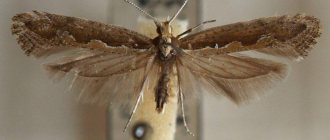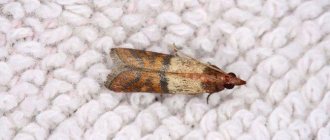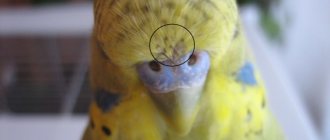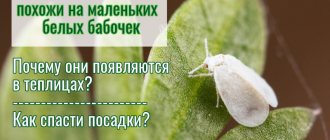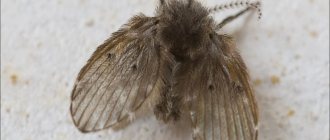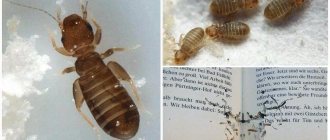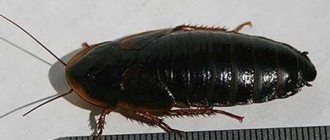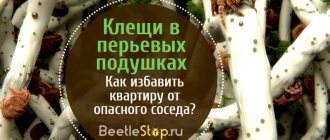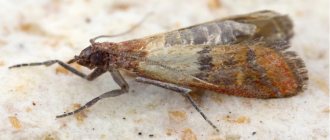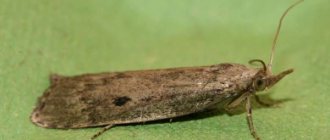The food moth is a pest of food supplies, living where there is free access to food: cereals, bread, dried fruits, etc. The insect is resistant to many insecticides and multiplies quickly, so the fight against it can be long-term.
The moth larvae that survive disinfection treatment emerge as adults and lay eggs in new places. In addition, the proximity of food and kitchen utensils imposes restrictions on the use of many toxic agents.
Appearance of food moth.
Types and description of the pest
The kitchen moth is similar in appearance to its relative. For this reason, it is not difficult to describe what a food moth looks like. The adult is a small, inconspicuous butterfly. The length of its body varies between 10-12 mm, and the wingspan is on average about 8 mm.
In the kitchen you can find one of several varieties of food moths.
- The flour moth is distinguished by the brown color of its wings. They are lighter closer to the body, and have dark triangles at the edges.
- The bread moth (barn or grain moth) has a straw or gray-yellow color and a wavy fringe along the edges of the wings.
- The fruit moth differs from the others by stripes on the surface of the wing.
- The cocoa moth has a light yellow tint to its wings.
Having noticed small butterflies in the kitchen, it makes sense to compare their appearance with a photo of a food moth.
Some facts about moths
Under natural conditions, moths feed on various grains, nuts, plant fruits, wool or animal down. Their whole life is completely subject to natural conditions and changes in the seasons.
The ideal place for moths is a human dwelling.
However, man was able to offer them more favorable living conditions, simplifying their lives as much as possible. In the warmth and abundance of food, moths can reproduce all year round, and moth larvae develop much faster.
It is clear that at every opportunity she tries to get into human habitation, especially since people themselves contribute to this in every possible way by carrying home things infested with larvae.
Moths are ubiquitous. You can meet this insect in every corner of the planet. However, the largest populations choose habitats with a temperate climate - steppes and forest-steppes. In human habitation, moths can carry out their life activities even in the Arctic.
In addition to favorable living conditions, in indoor conditions there are no natural enemies of the insect that would prevent rapid reproduction.
The most common types of moths in Russia are :
- barley;
- furniture;
- cabbage;
- grain;
- apple;
- fur coat;
- rye;
- burdock;
- waxy;
- woolen;
- wardrobe;
- barn.
Already from the name itself it is clear what moths eat, and that each insect specializes in a certain type of food. But it is worth considering that there are no restrictions within one species, and the larvae can easily switch from one diet to another.
The difference between the food moth and its clothes relative
To accurately determine the type of pest, you need to know that clothes moths are slightly larger than food pests. Adult kitchen moths lack the pearlescent tint on their wings that is characteristic of clothes moths.
The larvae cannot be identified externally due to their similarity. However, this can be easily done by the way they are fed. Kitchen moth larvae feed on grocery products, and clothes moths lay eggs on the surface of woolen items, hats, fur coats or carpets.
What does it eat and what is it afraid of?
Traces of moth activity.
The moth feeds in the kitchen on flour, cereals, bran, pasta, dried fruits, nuts, and dried mushrooms. You can notice it by the grains stuck together, somewhat similar to a cobweb.
Plastic bags are not a hindrance for moth larvae; they easily gnaw holes in them and easily migrate from one bag to another if they lack food.
Butterflies cannot tolerate specific odors, for example, fresh orange peels, garlic cloves, bay leaves, lavender, mint, tansy. But these methods are only applicable against butterflies; aromas do not affect the larvae and eggs.
To destroy food pest larvae, there are household chemicals.
Life cycle of a pest
Adults live two to three weeks and, according to scientists, do not need food. During this period, females lay eggs, from which small larval worms appear after 7-8 days.
The larvae actively feed and live for about 10 days. Then they create cocoons in the rump from specific secretions, similar to a web, and their excrement. After two weeks, an adult butterfly emerges from the cocoon, ready for further reproduction.
The easiest way to detect moths in the kitchen is at the larval stage in packages or containers with pasta, flour, cereals or dried fruits.
What does it look like and where does it lay eggs?
The food moth is a flying insect up to 1 cm long, externally similar to a moth of heterogeneous grayish-brown color. The inconspicuous color of the body and wings helps the pest remain unnoticed among the products. The moth lives mainly in pantries with groceries and in the kitchen, so people call it differently - food, kitchen, flour, fruit, cereal.
The insect lays eggs directly in cereals or on packages with them.
A female food moth produces from 50 to 400 eggs over the entire life cycle. They are so small that they cannot be seen with the naked eye. The eggs hatch into larvae - small caterpillars, which cause the main damage to food supplies. During their life, moth larvae weave a web to form a cocoon, from which a butterfly then emerges.
Food moth in food products.
Harm from food moths
When you detect the first signs of the presence of food moths in the kitchen, you should make every effort to destroy it.
Adults do not pose a danger to human health, except that they may accidentally fall into a cup of tea or a bowl of soup, thus spoiling the contents. The larvae, when they get into packaging with bulk products, make them unfit for consumption. Contaminated products entering the human body can provoke:
- development of an allergic reaction;
- digestive disorders;
- decreased local immunity;
- poisoning.
Moving through kitchen cabinets in search of food, worms are capable of carrying various infections.
In addition, the very fact of the presence of a food pest in a room with food products causes serious psychological discomfort among the inhabitants of the apartment.
Note!
How to descale a kettle: vinegar, citric acid, soda, brine, soda. TOP most effective cleaning methods!
Blinds for the kitchen: how to choose, what they are, photos of new designs
DIY kitchen mitts: diagrams, patterns, tips, original designs and new items (200 photos)
Feeding characteristics of moths
Food moth.
These parasitic insects existed long before the rise of civilization. Numerous species have flourished in nature and only relatively recently began to invade human habitation. Outside of it, they seek refuge in bird nests or rodent burrows.
Small larvae may feed on fur or feathers that fall from their owners.
Such nutrition is considered rather meager, and in combination with constant temperature fluctuations, it does not allow pests to multiply intensively.
The situation is completely different in indoor conditions, where moths can breed all year round thanks to uniform temperatures and an abundance of food, which can be furniture upholstery, clothes from the closet or carpets. Such features make the parasite dangerous for humans, because you don’t know in advance what expensive item might be damaged.
Fruit moth on dried fruits.
Food moths settle in the kitchen, since there is all the necessary food for it: dried fruits, cereals, flour and other food products. In nature, insects eat the supplies of ants or mice. If this pest was found in the kitchen, then you don’t have to worry about your clothes, since each variety selects a separate menu for itself and almost never changes it.
Parasites that have chosen a closet as their place of residence immediately look for shelves with fur or cotton textiles and begin to little by little chew off individual hairs. The resulting food is crushed and swallowed by insects. Well-fed parasites continue to cut tissue fibers in order to move forward.
As a result, the owners receive a damaged item that cannot be repaired.
Reasons for the appearance of moths in the kitchen
It should be understood that moths cannot start on their own. It always comes from outside. For this reason, the owner of even the most sterile kitchen may face the task of removing food moths.
Adults are able to enter the apartment through an open window, vent or ventilation hole. It is only a matter of time before the pest spreads further. The risk of moths appearing is especially high in apartment buildings where there is a grocery store or catering outlet on the ground floor.
Often, food moths appear in an apartment after purchasing food, feed or seeds contaminated with larvae. Protective measures include screens on windows and ventilation openings, as well as careful inspection of food, seed or feed packages before purchase.
Features of the structure and life cycle of the food moth
Food (flour, grain) moths are insects that have adapted to live close to humans. In nature, there are several types of it: granary, cereal, nut, etc. It is worth clarifying that it is the larvae of food moths that feed and spoil food products, while adult individuals do not have a mouthparts, and they cannot feed at all.
The term “food moth” is used to describe the vast majority of granary pests representing the Moth family. By external characteristics, insects from this family are easily distinguishable from each other, but there are a number of characteristics inherent in absolutely all species of this taxon:
- Small size (the largest butterflies have a wingspan of 4.5 cm, but most species have a maximum size of 1 cm).
- Dim coloring of the body and wings (with a few exceptions).
- High sensitivity of the antennae.
- Wings edged with fringe.
- Large eyes.
Insects of each species have their own unique pattern on their wings. Considering what a food moth looks like, it becomes clear that individuals within a species differ little from each other. The moth has white or yellowish wings, a darker head and an elongated body reaching 1.5 cm in length. The butterfly's body is divided into segments. Their tenacious paws help them move across surfaces. You can see what food moths look like at the butterfly stage in photo 1.
The food moth development cycle includes 3 stages: egg, pupa and butterfly. If the conditions are right, the insect larva will complete its development in 60 days. The imago - an adult - has a very short life. As mentioned above, adults do not have a mouth, and their food system is reduced to a primitive level. But how long does an insect live that is deprived of the opportunity to feed? This stage of the life cycle takes only 1 week. Butterflies die quickly because their body is not adapted for a long life.
Having completed development at the pupal stage, the moth proceeds to reproduction. To do this, it releases chemicals into the air that attract representatives of the opposite sex. A male who lives only for sexual intercourse dies soon after. After fertilization, females need to find a place to lay eggs. It is best to organize the clutch directly near the food source - in flour, in cereals and in other food products. One female insect can produce offspring of 100 eggs. To prevent the larvae from interfering with each other during development, the female takes care of the dispersal of the clutches. After she lays her last fertilized eggs, her life cycle ends and she dies.
An insect larva that has hatched from eggs is forced to eat a lot in order to gain a certain weight. This is necessary for the larva to develop into an adult. The moth eats a lot, but moves very little, so as not to waste the energy received from food (photo 2). The movements of the pupa are caused solely by the search for food. Before the transformation itself, the insect is forced to look for a place for the last transformation.
It takes at least 10 days for a food moth egg to form a pupa. During this period, insects reach 15 mm in length and weigh as much as necessary to move to the next stage of the cycle. The presence of food moths in an apartment, as a rule, is detected precisely at this stage, since the pests begin to actively move. Insect eggs can only be discovered by chance.
The pupal stage lasts several days. During this time, the insect's body undergoes major metamorphoses, turning a fat, worm-like larva into a fragile butterfly. The imago formed from the pupa is immediately ready to fulfill its purpose - to give birth to new offspring.
Favorable conditions for the development of flour moths
Like any living creature, the food moth needs the presence of favorable factors, without which its life, and especially reproduction, will be impossible. She feels comfortable at a temperature of +25 degrees and a relative humidity of 50%. If the temperature is below the specified level, insect eggs have nothing to fear - they simply “wait out” the unfavorable period.
In 1 year, 2 generations can change in one specific population of mealy moths. High fertility allows the pest to occupy large areas in a short period of time.
Traces of vital activity or the insects themselves can be found wherever there is food. The moth lives at high positive or low temperatures, although not for long. This is important to know for those who do not know how to remove food moths.
The initial stage of pest destruction
When you discover the first signs of kitchen moths in your apartment, you need to take certain actions to get rid of the pest.
- To do this, first of all, you will need to sort through all the bags, pouches and other containers with food products in order to identify the pest larvae.
- If you find pasta, flour, cereals and other products affected by worms, you should get rid of them.
- You will have to spend time examining all stocks of nuts, dried fruits, dry food, seeds, cereals and other bulk products for contamination. All spoiled stocks must be destroyed as they are unsuitable for further use. Their further storage will lead to active reproduction of the pest in the apartment.
- Food reserves that seem untouched at first glance should be calcined in a frying pan or frozen for a couple of days.
- The next step is to treat the kitchen cabinets and shelves. They must be washed with soapy water or a solution of vinegar and water. In this case, special attention must be paid to seams and door hinges. It is convenient to treat narrow cracks and hinges with a brush dipped in a vinegar solution.
After careful treatment, the cabinets are left with the doors open for ventilation and drying.
What harm does
Moth in the cereal.
Unlike ordinary butterflies, which breed in the summer, the food species in an apartment can breed all year round. This is one of the reasons why food moths are dangerous and why they need to be removed as quickly as possible.
It usually starts in products that have expired or when sanitary rules are violated. She wanders around the kitchen cabinet and eats everything that comes in her way. The pest especially loves cereal products, pasta, flour, nuts, dried fruits, and candies. All products that end up in cabinets contaminated with moths and their larvae will be spoiled.
You may wonder if food moths eat clothes. The answer is clear: it is not dangerous for fur and wool products.
Cleaning the premises
Experts recommend not limiting yourself to washing kitchen cabinets and shelves, but carrying out a general cleaning of the entire room after a complete audit of food supplies.
All furniture, floors and walls should be thoroughly washed with a solution of laundry soap, and then wiped with vinegar diluted with water. The gaps between kitchen furniture and walls need to be vacuumed, as well as the spaces between cabinets and cabinets.
Adults can hide under the windowsill, on the ceiling or on the wallpaper. Therefore, it makes sense to use chemical pest control agents after eliminating spoiled products and general cleaning of the premises.
How our grandmothers escaped
It is unsafe to carry out treatment with chemicals, so our grandmothers found effective alternative methods. Garlic, known for its disinfectant and insect repellent properties, was placed in storage areas. Vinegar also helps get rid of most household pests if the solution is thoroughly applied to the entire surface of the kitchen cabinet. In such rich aromas, moths are unlikely to want to eat. After the procedure, the room is ventilated.
The food moth does not like the smell of lavender or bay leaf; once it smells it, it will soon leave the house. Storage areas are also treated with a saturated soda solution. For greater effectiveness, it is worth constantly changing protective equipment so that the insect does not adapt.
Chemicals against kitchen moths
When deciding how to quickly get rid of food moths, you should pay attention to modern chemicals that have a targeted effect against the pest at any stage of its life cycle.
Active drugs can be divided into two types:
- insecticides that can destroy the pest;
- repellents aimed at scaring away adults capable of laying eggs.
How to get rid of moths in cereals in a warehouse
The proliferation of food moths in a warehouse indicates a lack of timely processing. Control methods in this case will depend on the type of pest and its quantity. Only a specialist can determine the degree of infection. After his report, a solution method is established. It could be:
- chemical treatment;
- mechanical screening;
- steam treatment;
- wet gas disinfection.
For small foci of infection, a SES worker can use aerosol spraying.
Insecticides
Modern drugs have different forms and principles of use.
Aerosols are undoubtedly the most effective option for getting rid of food moths in the kitchen. But, at the same time, they require the most serious precautions. Before using them, you must remove all food from the premises, and also take family members and pets outside to avoid poisoning.
After a certain period of time required for exposure to active substances, you should ventilate the room and wash all surfaces where the toxic mixture sprayed in the air could settle. Combat and Raptor do an excellent job of repelling food moths.
Flat plates for a special fumigator device are also an effective remedy for food moths, since they act on adults and larvae. The plates are inserted into the device, which, heating up when plugged in, sprays a substance toxic to the pest. Solid balls and crystals also release toxic substances, which kill larvae and adult moths.
Methods of disposal
In order to remove food moths, you need to take the following steps:
- carefully examine all possible insect habitats;
- find a clutch of eggs;
- get rid of larvae;
- treat contaminated surfaces with insecticides.
It is also necessary to destroy adult individuals: each female moth lays up to 400 eggs in different places, from which a new generation of pests then develops.
At home, to combat insects, you can use folk methods or store-bought remedies: fragrant herbs, essential oils, traps, plates, sprays and fumigators.
Destruction of larvae
To find the places where the caterpillars live, you need to go through all the bags of groceries and conduct an audit of household preparations: dried herbs, mushrooms, apples, etc. Most often, food moths lay eggs in semolina and dried fruits, so first of all it is worth inspecting these products . Contaminated packages and bags of food supplies should be thrown away.
It is necessary to disinfect the moth habitats, and then use mechanical means to catch butterflies: traps, sticky tape, a fly swatter or rolled newspaper.
Chemical preparations for food moths
Insecticides that kill food pests can be purchased at hardware stores or specialty departments of supermarkets. Chemicals should be used according to the attached instructions.
The most effective poisons that get rid of food moths include:
- Gel or liquid con.
- Concentrated emulsion "Breeze".
- Aerosol insecticides “Armol”, “Antimol”, “Raptor: protection against moths”.
It is necessary to poison insects during the absence of all family members and pets, since some products can be hazardous to health. Before treating the room, you should protect your respiratory tract with a respirator or medical mask.
Glue trap for food moths.
Food products and all utensils that come into contact with food must be sealed. After disinfection, you need to wash your hands and rinse your mouth if the smell makes your throat sore. Then you should leave the room for a while.
The use of folk remedies
Traditional methods will also help get rid of insects. Moths cannot tolerate strong odors, so odorous oils, foods and herbs are used to combat them:
- Essential oils of lavender, geranium, cloves, wormwood. They impregnate cotton swabs and place them on kitchen cabinets, use them in aroma lamp mixtures, and add them to water for wet cleaning.
- Citrus fruit peels. The dried zest is sewn into canvas bags, which are placed in food storage areas.
- Vinegar. Shelves, cabinets, and countertops are treated with a strong solution.
- Dried herbs. Dry bouquets of fragrant herbs (dill, tansy, lavender) are hung on the walls, placed on shelves and inside cabinets with food supplies.
Substances with a strong odor repel insects, but do not have a harmful effect on them. Therefore, it is better to use folk remedies in combination with other means of combating moths.
Repellents
The products included in this group are recognized as absolutely safe for humans. The disadvantage of these products is that they destroy or repel only butterflies and have no effect on worms.
They are produced in the form:
- sticky trap tape that attracts butterflies;
- plates that repel pests from products.
For this reason, a food moth trap, like a plate, serves more as a means of prevention than active pest control.
Appearance, lifespan and development
There are several types of food moth, the most common is the cocoa moth , which likes to wander around “its” places only at night. It looks like a small butterfly, no more than 1 cm in size. Its color is inconspicuous , from brown to gray with small dots.
The insect lives for several weeks , but during these days it produces large offspring. Reproduction occurs only when there is free access to water. The kitchen moth does not consume food because it does not have a developed digestive system. Its larvae eat the food .
Development goes through three stages: laying eggs, intensive development, and birth.
What does a food moth look like, photo below:
Folk methods of struggle
The use of ancient methods of pest control is based on the fact that moths are repelled by pungent odors. Therefore, to protect food supplies they often use:
- garlic;
- laurel leaf;
- tobacco;
- citrus peels;
- aromatic herbs and spices.
Fragrant leaves of rosemary, mint, lavender, as well as cloves, allspice, and bay leaves are placed in cabinets and containers with bulk products.
Periodically, it is recommended to wash grocery storage areas with diluted vinegar.
How to get rid of it using folk remedies
To effectively fight a food pest, you need to find out how the insect appears in the kitchen, what places it avoids, where it prefers to settle, what factors are irritating and destructive for it. For the purpose of control or prevention, you can use simple folk remedies, including plants and products with a specific smell that repels moths:
- Garlic. The phytoncides emitted by the spice are unpleasant to the insect. Peeled garlic cloves must be placed in all drawers and on all shelves in the kitchen cabinet. If you have a pantry in your house, then you should put garlic there too.
- Lavender. The smell of this flower also repels moths. The brooms of the dried plant can be hung or placed near food supplies. You can make decorative bags with lavender contents and decorate your kitchen with them.
- Spices. Cloves and bay leaves have a repellent effect.
- Herbs. It is recommended to place sprigs of wormwood and peppermint in the kitchen.
- Citruses. The smell of citrus fruits is a strong irritant for food moths. You can treat your kitchen furniture with orange or lemon essential oil, or put citrus peels on shelves and drawers.
It is easier to prevent any problem than to deal with it. This also applies to insect control. There are activities that you can do without worrying about moths spoiling your food. Preventive measures include:
- thoroughly checking for the presence of larvae and eggs of all purchased bulk products (flour, cereals, sugar, seeds, nuts), especially unpackaged ones;
- purchasing only high-quality and fresh products (do not chase promotions; a price reduction is a sure sign that the goods are stale and spoiled);
- replenishing food supplies only as they are depleted (do not keep large quantities of flour, sugar, and cereals at home);
- regularly cleaning and wiping the shelves and drawers of the kitchen cabinet;
- storage of bulk products in hermetically sealed containers, glass or metal;
- regular ventilation of the kitchen, wet cleaning;
- Immediate disposal of spoiled food;
- constant use in the kitchen of herbs, spices and essential oils that are pleasant to humans, but irritating to insects (lavender, bergamot, rosemary, citrus oils are suitable).
Some housewives use a simple and effective method of preventative treatment of store-bought nuts or cereals. The product is poured into a suitable container, placed in the microwave for half a minute, and kept at maximum power. During this time, neither nuts nor cereals will be baked, and the larvae, if any, will be destroyed.
If the housewife regularly evaluates the state of food supplies, is attentive to the purchase of food products, stores food correctly, maintains order in the kitchen, and applies preventive measures, then she will not have to deal with the issue of destroying food moths.
Preventive measures
As part of preventive measures, it is recommended to follow a few simple rules.
- You should not purchase large quantities of grocery products for future use, especially flour, cereals and pasta.
- When purchasing, you should carefully check the strength of the packaging and the condition of the product. The presence of fine dust and debris may be a sign of infection.
- After purchasing, it makes sense to pour the product into sealed containers for storage.
- Aromatic herbs, spices and garlic cloves on the shelves will repel butterflies from the products.
- Regular ventilation of the room will also serve as a useful preventative measure, since moths do not tolerate drafts well.
- It is effective for timely detection of moths to regularly inspect food supplies and clean cupboards.
How does this parasite appear?
This issue seriously worries many housewives and they believe that they themselves are to blame for the appearance of these parasites in the kitchen. In fact, it's not at all what it seems. After all, most, if not all, food is purchased at the store, where it is processed and can become contaminated with food moths. This is due to the fact that products are not stored at all bases, as prescribed by the rules. In addition, moths can enter the room through windows or through ventilation.
Food moths choose special places for their lives. For example:
- Between the croup. It thrives in areas where rice, oatmeal, oatmeal and pasta are stored. Even in bags with cereals you can find digestive moths there.
- Among the walnuts. Moths are found in shelled peanuts, under the shells of walnuts, etc.
- Among dried fruits. Where dried apricots, plums and raisins are stored, it is clear that over time they become covered with a kind of film. It can be assumed that they are infested with moths.
- Between cardboard boxes. Moth larvae are also found in unwrapped tea bags, oatmeal or cornflakes.
- If it is not possible to get rid of the moth for many years, then we can assume that it lives in this room, hiding in various crevices and other secluded places. Sometimes found in unused devices.
- Some experts say that moths are afraid of garlic, but this is not at all true, since they were also found among garlic.
- It can also live in foods it doesn't eat. This can be salt, soda and other bulk products. Therefore, when inspecting, it is necessary to pay attention to all products.
The only place where moths are not found is in liquid foods.
If this parasite is detected, do not panic. On the contrary, we need to come together and begin to destroy this parasite.
Photo of moth
How harmful and dangerous are moths?
Many people who do not know this believe that food moths are absolutely harmless to humans. In fact, everything is much more serious. The fact is that an adult can lay up to 500 eggs.
As the larva grows, it manages to change its skin several times and contaminates food with its vital activity. As a result, many insect feces and old skin become concentrated in grains, nuts, and other foods. If you regularly eat contaminated foods, you may find that:
- Food poisoning, which will lead to severe intoxication of the body.
- Allergic reactions, including angioedema, which can be fatal.
- Reduced immunity.
Most experts say that if this parasite is discovered, it should be eliminated as soon as possible. A particularly dangerous moth for children. Their bodies are not yet strong, so eating contaminated food can cause serious consequences.
Varieties of moths
There are several types of home moth; each group gives preference to its favorite product, but does not neglect others. There are eight main types of household pests.
- Flour moth. The firefly is small in size with beige colored wings. This type of insect reproduces faster than its counterparts. If you notice small cocoons in the flour, it means that the parasite has entered the house. Sift the flour through a sieve, then cook in the oven for at least half an hour. Store flour in an airtight container.
- Grain moth. A firefly with narrow wings of a yellowish tint, the color is similar to the color of grain so that it can blend in with it. She focuses on buckwheat, rice, rye and wheat. The safest way to get rid of the parasite is to use special traps.
- Mill moth. A butterfly up to 1.5 cm in size, with dark gray dotted wings. This type of moth is rarely found in apartments; they are usually found in mills.
- Potato moth. A small, inconspicuous moth with gray wings and long antennae. The larvae like to attack old potatoes, as their tubers are softer. They bite into fruits, causing rotting. You can fight potato moth by adjusting the storage temperature of root crops below 0°C. For a better effect, tubers can be treated with biological preparations.
- Onion moth. Wingspan up to 17 mm. The body and fore wings are brown, the hind wings are gray with fringe. The larvae eat the onion, causing the vegetable to rot.
- Cereal moth. A butterfly with silver-gray wings, the span of which reaches 14 mm. The larva destroys cereals and seeds, gluing the grains into pellets using a web. Its appearance indicates that the grain has already been stored in the warehouse.
- Chocolate moth. Eats coffee, cocoa beans, chocolate and other “confectionery”. She makes passages in chocolate products, leaving behind grains of feces. The size of the worms does not exceed 0.5 cm, so they fit into the smallest holes in the wrapper.
- Fruit moth. The gray butterfly, approximately 10 mm in size, is nocturnal. Moths grow in dried fruits, fruits and mushrooms. Its larvae break through canals, turning the fruits into dust. The insect does not disdain other products, so you can see moths in walnuts, almonds or hazelnuts.
In the apartment, food moths eat all grocery products. Therefore, first check for caterpillars:
- cereals;
- pasta;
- beans;
- peas;
- flour;
- sugar;
- candies;
- nuts and dried fruits;
- bread;
- cookie;
- spices;
- tea;
- coffee;
- cocoa;
- animal feed.
Different types of parasites can easily live next to each other. Therefore, when you find a moth, carefully check not only your food, but also your wardrobe.
Direct and indirect harm
When assessing the danger of moths appearing in an apartment, they first of all talk about spoiled products and things. This is direct harm, but there is also indirect harm. So, having discovered a food moth in a bag of flour, most housewives will throw away not only it, but also all nearby products, since they may also contain insects that have gone unnoticed.
As for clothes moths, indirect harm can be caused when trying to cope with them. For example, washing woolen items in hot water may cause them to change shape or size. The same applies to the use of untested means that can ruin the item.
Clothes
But the question of whether moths are dangerous for people is inappropriate in this case. The insect does not bite, does not carry pathogens, and therefore poses no direct harm to humans.
